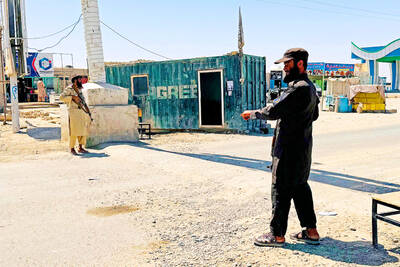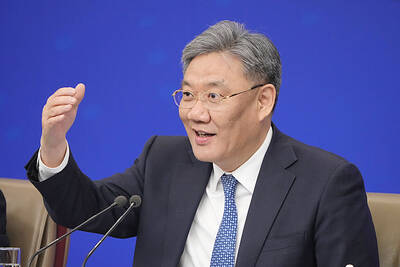It has been sought for centuries, but remained a mystery. Now an expert has pinpointed a site that could be Atahualpa’s resting place: the last Inca emperor’s tomb.
“This is an absolutely important find for the history of Ecuador’s archeology and for the [Andean] region,” Ecuadoran Patrimony Minister Maria Fernanda Espinosa said, referring to the ruins found by historian Tamara Estupinan.
The Inca empire, in the 1400s and early 1500s, spanned much of South America’s Andean region — more than 1,600km — from modern-day Bolivia and Peru to Argentina, Chile, Ecuador and Colombia. It included dozens of ethnic groups with different languages, cities, temples, farming terraces and fortresses.

Photo: AFP
Atahualpa was the last of his dynasty. During the Spanish conquest he was taken captive in what is now Cajamarca, Peru.
He had been pressed to convert to Christianity and then the Spanish executed him by strangulation. After his death in 1533, the empire began to fall apart.
This year Ecuador’s state Cultural Patrimony Institute will start work on a promising archeological site and Estupinan will be front and center to raise the curtain on a massive complex sprawling over a ridge at 1,020m.
It was back in June 2010 that Estupinan, now a researcher with the French Institute for Andean Studies (IFEA), found what she describes as an “Inca archeological site” high on the Andes’ eastern flank amid plunging canyons. Nearby are a small local farm and a facility for raising fighting cocks.
However, in the area called Sigchos, about 72km south of Quito, up on a hill dotted with brush, there is more — much more: She found a complex of walls, aqueducts and stonework that lie inside the Machay rural retreat. Machay means burial in the Quechua language.
“This is a late imperial design Inca monument that leads to several rectangular rooms that were built with cut polished stone set around a trapezoidal plaza,” Estupinan said.
Archeologist Tamara Bray, of Wayne State University in Michigan and a colleague of Estupinan, confirmed that the site boasts “an Inca edifice that is phenomenally well preserved and quite important scientifically.”
Inside the facility, a walled walkway starts at the Machay River and one can see the shape of an ushno, essentially stairs that form a pyramid believed to be the emperor’s throne. Meanwhile, a tiny cut channel of water would spout out a small waterfall nicknamed “the Inca’s bath.”
Georges Lomne, the director at the Lima-based IFEA, said the find appears to confirm that the Incas were active and present in a lowland area well outside what their best-known area of operations were: Andean highlands.
“Malqui-Machay is part of a broader complex that also would have included the Quilotoa lagoon and the area called Pujili [Cotopaxi],” he said.
“All of this belonged to Atahualpa. It was his personal fiefdom in the way that French [and other] kings had royal domains,” he added.
Bray also said that “very few such Inca sites have been found in this type of tropical lowland. I think that the Incas used it as a sort of getaway.”
Estupinan has some more specific ideas.
She believes Malqui-Machay is Atahualpa’s final resting place. The tomb of the last capac of Tahuantinsuyo, the trans-Andean empire.
While many experts have other theories, Estupinan believes that when Atahualpa was killed, his remains could have been brought by his most loyal man, Ruminahui, to Sigchos for burial, to a place where Ruminahui based his fight for survival against the European intruders.

‘EYE FOR AN EYE’: Two of the men were shot by a male relative of the victims, whose families turned down the opportunity to offer them amnesty, the Supreme Court said Four men were yesterday publicly executed in Afghanistan, the Supreme Court said, the highest number of executions to be carried out in one day since the Taliban’s return to power. The executions in three separate provinces brought to 10 the number of men publicly put to death since 2021, according to an Agence France-Presse tally. Public executions were common during the Taliban’s first rule from 1996 to 2001, with most of them carried out publicly in sports stadiums. Two men were shot around six or seven times by a male relative of the victims in front of spectators in Qala-i-Naw, the center

Incumbent Ecuadoran President Daniel Noboa on Sunday claimed a runaway victory in the nation’s presidential election, after voters endorsed the young leader’s “iron fist” approach to rampant cartel violence. With more than 90 percent of the votes counted, the National Election Council said Noboa had an unassailable 12-point lead over his leftist rival Luisa Gonzalez. Official results showed Noboa with 56 percent of the vote, against Gonzalez’s 44 percent — a far bigger winning margin than expected after a virtual tie in the first round. Speaking to jubilant supporters in his hometown of Olon, the 37-year-old president claimed a “historic victory.” “A huge hug

Canadian Prime Minister Mark Carney is leaning into his banking background as his country fights a trade war with the US, but his financial ties have also made him a target for conspiracy theories. Incorporating tropes familiar to followers of the far-right QAnon movement, conspiratorial social media posts about the Liberal leader have surged ahead of the country’s April 28 election. Posts range from false claims he recited a “satanic chant” at a campaign event to artificial intelligence (AI)-generated images of him in a pool with convicted sex offender Jeffrey Epstein. “He’s the ideal person to be targeted here, for sure, due to

DISPUTE: Beijing seeks global support against Trump’s tariffs, but many governments remain hesitant to align, including India, ASEAN countries and Australia China is reaching out to other nations as the US layers on more tariffs, in what appears to be an attempt by Beijing to form a united front to compel Washington to retreat. Days into the effort, it is meeting only partial success from countries unwilling to ally with the main target of US President Donald Trump’s trade war. Facing the cratering of global markets, Trump on Wednesday backed off his tariffs on most nations for 90 days, saying countries were lining up to negotiate more favorable conditions. China has refused to seek talks, saying the US was insincere and that it